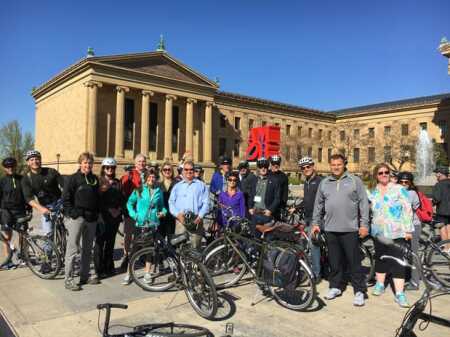Philadelphia is a city of neighborhoods—as are many other cities. But only Philadelphia can boast a human-scale walkable layout planned by William Penn more than three centuries ago. “We have great bones,” remarked Patricia Blakely, executive director of the Merchants Fund, speaking at the ULI Spring Meeting in Philadelphia. Unlike some other older cities, noted moderator Stephen Mullin, president and principal of Econsult Solutions, “We don’t repel natives; there isn’t much brain drain; our neighborhoods are dynamic.”
Blakely heads a nonprofit established in 1854 to provide charitable gifts to businesspersons facing financial hardship. In recent years, the fund has helped energize key neighborhoods by supporting local entrepreneurs. “New Americans are driving the train here,” she said. “We have Africans selling to other Africans, then expanding their businesses by exporting and importing, taking up vacant commercial space. Keeping shop is hot; people are drawn to artisanal hyper-local offerings. Cambodians, Laotians, and other immigrants have replaced many Italian-owned businesses in South Philadelphia, and now that neighborhood has a zero commercial vacancy rate.”
To build on this trend, community development organizations are “curating neighborhoods,” Blakely went on. “It seems that every neighborhood wants its own micro-brewery; the latest trend is garden centers.” Local entrepreneurs are bringing new life to the city’s avenues, which originally were turnpikes radiating from the city’s core.
Real estate developers and investors also are advancing the city’s urban renaissance. Craig Grossman, a general partner of Arts & Crafts Holdings, moved to Philadelphia from New York City in 1999 and found that Philadelphia’s downtown—called Center City—was a “hole in the doughnut,” surrounded by revitalization projects. The intersection of 13th and Sansom Streets, just two blocks south of City Hall, was the locus of a red-light district. The neighborhood’s low-rise buildings were largely vacant; retail tenants were of the undesirable variety.
Grossman’s company began purchasing property in the area, eventually accumulating 24 properties with just over 400,000 square feet (37,161 sq m) of space in a two-block blighted zone on and around South 13th Street. Upon taking title, Grossman managed the master planning, architectural and design process, and rehabilitation and construction of these buildings.
“We wanted to preserve history, embrace memories, and find the next generation of entrepreneurs,” he said. “We worked with them, helped them with marketing, and sometimes provided seed money to help them grow.”
Grossman focused on bringing local entrepreneurs to the area, particularly restaurants and boutiques. These new tenants created a merchants’ association, branded the neighborhood “Midtown Village,” launched festivals, and otherwise promoted the neighborhood. Now the area is home to a wide variety of restaurants and shops attracting both tourists and locals—including attendees at ULI’s Spring Meeting.
But Grossman needed a new challenge. So he is taking his revitalization model to a new neighborhood, dubbed the Spring Arts District, on the northern edge of Center City. Affiliates of Arts & Crafts Holdings currently own more than 200,000 square feet (18,580 sq m) in the area, some along an old Reading Railroad right-of-way. “This former industrial neighborhood, walkable to Center City, has been passed over for decades,” Grossman said. “I am trying to assemble a critical mass of property, bring in public art, and curate every square inch, from the sidewalks to the roofs.” He plans to promote and grow a community of artists and craftspeople in a vibrant urban district that includes artists’ and crafts persons’ studios, an eclectic collection of shops, and a commercial office complex.
Farther west, near the bank of the Schuylkill River and the iconic Philadelphia Museum of Art, the Brewerytown neighborhood is undergoing transformation, thanks to the efforts of homegrown developer David Waxman of MMPartners (MMP). With sturdy homes built by German immigrants, this historic district once had more breweries than anywhere else in the world, said Waxman. By the late 1980s, all the breweries had closed down, and the neighborhood was hit hard by the crack cocaine epidemic.
About 15 years ago, MMP began acquiring property and building in Brewerytown. After 2008, MMP saw the opportunity to redevelop part of the compact retail corridor along Girard Avenue. “We provided storefronts free to artists, pop-ups, you name it,” he said. Girard Avenue now has a coffee shop run by a nonprofit organization that provides job training for teenagers aging out of the foster care system. Some 15 new businesses have opened, including a bike shop, pharmacy, yoga studio, and pizza restaurant. MMP is actively renovating single-family homes and building new ones. “The first-time homebuyer market has exploded in Brewerytown,” Waxman told attendees. “We have sold new homes to more than 30 of our own commercial tenants.”
Block-by-block redevelopment “pushes the bad stuff away,” said Waxman, but it is never easy. “It takes longer and costs more than you think,” he commented. “But urbanization is not slowing down. The action will continue to be in urban neighborhoods.”


![Western Plaza Improvements [1].jpg](https://cdn-ul.uli.org/dims4/default/15205ec/2147483647/strip/true/crop/1919x1078+0+0/resize/500x281!/quality/90/?url=https%3A%2F%2Fk2-prod-uli.s3.us-east-1.amazonaws.com%2Fbrightspot%2Fb4%2Ffa%2F5da7da1e442091ea01b5d8724354%2Fwestern-plaza-improvements-1.jpg)


